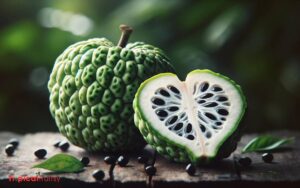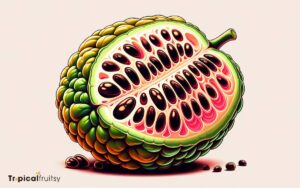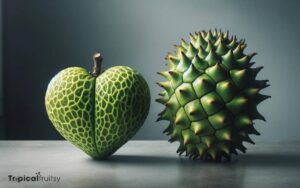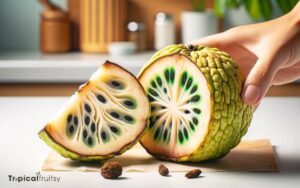Sugar Apple Vs Custard Apple Vs Cherimoya: Comparison!
Sugar apple (Annona squamosa), custard apple (Annona reticulata), and cherimoya (Annona cherimola) are three distinct fruits from the Annonaceae family, each with unique flavors, textures, and characteristics.
Sugar apples have a sweet, creamy texture and are segmented into knob-like sections. Custard apples are larger with a bumpy skin and a softer, custard-like consistency.
Cherimoyas have smooth, green skin and are often considered the most flavorful, with a taste described as a mixture of banana, pineapple, and strawberry.
These tropical fruits are similar but can be distinguished:
Sugar Apple
- Also known as sweetsop or atemoya.
- Smaller size with a bumpy segmented surface.
- Flesh is sweet and creamy with a grainy texture.
Custard Apple
- Also termed bullock’s heart or ramphal.
- Larger, heart-shaped with a rough, bumpy rind.
- Creamier and sweeter flesh than sugar apple.
Cherimoya
- Mark Twain called it “the most delicious fruit known to men.”
- Large, oval, with a green skin that is smooth or slightly bumpy.
- Creamy texture and rich flavor, often compared to a blend of tropical fruits.
For example, while enjoying a cherimoya, one might experience a complex flavor profile unlike the simpler sweetness of a sugar apple.
Discover the exotic flavors of the Annonaceae family with sugar apples, custard apples, and cherimoyas, each offering a distinctive taste and texture for a tropical treat.
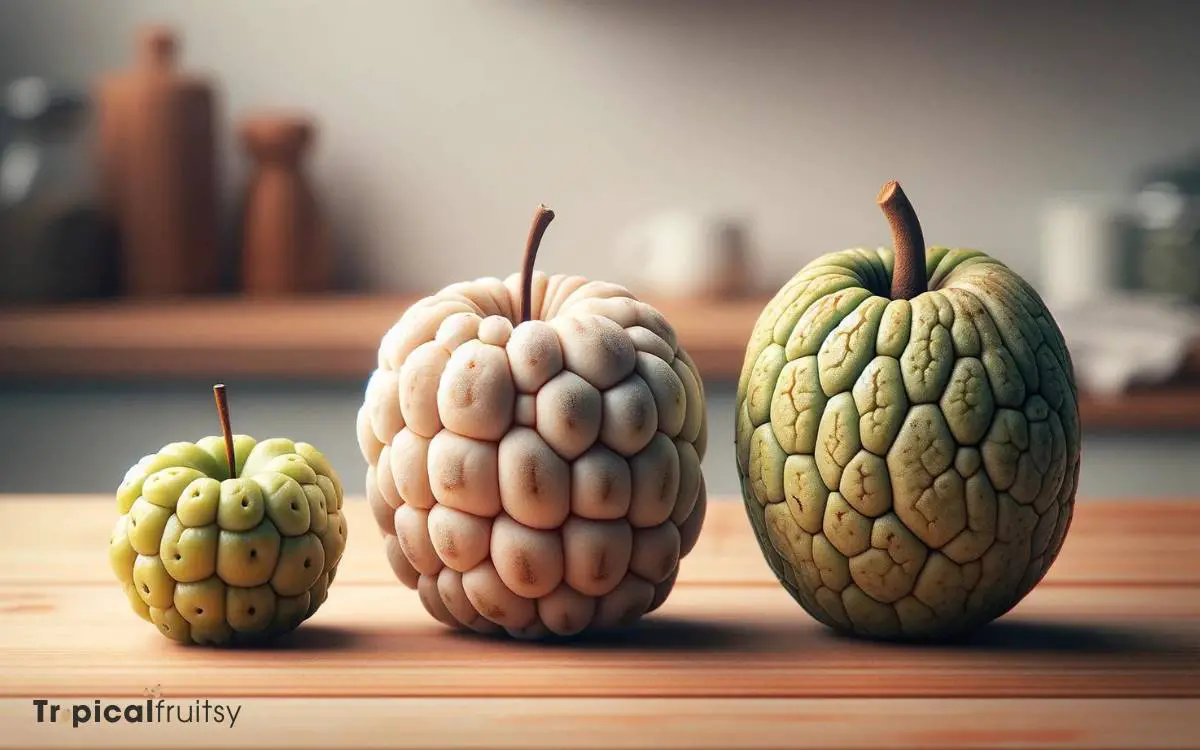
Key Takeaway
Sugar Apple, Custard Apple, and Cherimoya Features
| Feature | Sugar Apple | Custard Apple | Cherimoya |
|---|---|---|---|
| Scientific Name | Annona squamosa | Annona reticulata | Annona cherimola |
| Origin | Americas, West Indies | Caribbean, Central America | Andes Mountains |
| Skin Texture | Knobby and segmented | Bumpy and greenish-brown | Green with overlapping scales |
| Shape | Conical | Rounded | Heart-shaped |
| Flavor | Sweet, segmented flesh | Creamy and sweet | Blend of banana, pineapple, papaya |
| Nutritional Content | Rich in vitamins C and B, antioxidants | High in vitamin C, fiber, and antioxidants | Abundant in vitamins C and B6, fiber, and antioxidants |
| Culinary Uses | Desserts, beverages | Smoothies, ice creams | Salads, desserts, smoothies |
Origins and Taxonomy
The sugar apple, custard apple, and cherimoya are fruits of the genus Annona, native to the tropical regions of the Americas and the West Indies. Taxonomically, they’re classified within the family Annonaceae.
The sugar apple (Annona squamosa) thrives in warmer climates and exhibits a segmented rind. Custard apple, also known as bullock’s heart or Annona reticulata, possesses a more continuous rind surface.
Cherimoya (Annona cherimola), considered the finest-tasting among them, flourishes in subtropical areas.
Each species displays unique fruit morphology and flavor profiles, which are a result of their specific genetic makeup and environmental adaptations.
Their propagation and cultivation have spread to suitable climates worldwide, leading to a rich diversity of cultivars.
Physical Characteristics
Examining the physical traits of sugar apple, custard apple, and cherimoya reveals distinct differences in size, skin texture, and seed arrangement.
The sugar apple, or Annona squamosa, is smaller, with a diameter typically ranging from 5 to 10 centimeters. Its surface is segmented into knobby segments.
The custard apple, or Annona reticulata, is larger, with a more irregular shape and a skin that appears more net-like.
Cherimoya, or Annona cherimola, offers a smoother skin with fine scales and can vary greatly in size, often between 10 to 20 centimeters. These characteristics aren’t merely aesthetic; they influence handling and consumption.
The forthcoming discussion on ‘flavor profiles compared’ will elucidate how these physical properties correlate with taste.
Flavor Profiles Compared
Delving into the flavor profiles of sugar apple, custard apple, and cherimoya reveals distinct tastes ranging from sweet and creamy to subtly tart.
The sugar apple, or Annona squamosa, offers a rich sweetness coupled with a custard-like texture, often described as a blend of pear and coconut.
The custard apple, known scientifically as Annona reticulata, possesses a similar creamy consistency but with a more complex, nuanced sweetness and a hint of acidity, reminiscent of apple or banana.
Meanwhile, the cherimoya (Annona cherimola) is acclaimed for its sophisticated palate, combining the sweetness of the aforementioned fruits with a subtle tanginess, likened to a fusion of pineapple and papaya.
These distinctive flavor profiles contribute to their culinary versatility and individual consumer appeal.
Nutritional Benefits
Beyond their unique flavors, sugar apple, custard apple, and cherimoya each offer a plethora of nutritional benefits that contribute to a healthy diet.
These fruits are replete with essential vitamins, minerals, and dietary fiber, which are vital for maintaining optimal bodily function.
Notably, they’re rich in:
- Vitamin C, bolstering the immune system and acting as an antioxidant.
- Potassium, necessary for maintaining electrolyte balance and cardiovascular health.
- Dietary fiber, which aids in digestion and helps regulate blood sugar levels.
Each fruit also contains a variety of phytochemicals that have been studied for their potential anti-inflammatory and anti-cancer properties.
The consumption of these fruits supports not only macronutrient needs but also micronutrient diversity.
This nutritional profile enhances their appeal as ingredients in various culinary creations, leading us to the exploration of their culinary uses and tips.
Culinary Uses and Tips
The versatility of sugar apple, custard apple, and cherimoya extends beyond their health benefits, as these fruits are also prized for their culinary adaptability in both sweet and savory dishes.
These fruits can be consumed raw, where their creamy texture and sweet flavor are most pronounced. Moreover, they are frequently incorporated into desserts such as mousses, tarts, and ice creams.
The flesh of these fruits can also complement the richness of meats in savory applications, providing a delicate balance to the flavors.
| Fruit | Culinary Application |
|---|---|
| Sugar Apple | Pureed for beverages |
| Custard Apple | Incorporated into desserts |
| Cherimoya | Eaten fresh or as a sorbet base |
| All | Complements to savory dishes |
| All | Mixed into salads for a sweet note |
Conclusion
while sugar apple, custard apple, and cherimoya share taxonomic similarities, each boasts distinct physical traits, unique flavor nuances, and varied nutritional profiles.
These subtropical fruits not only provide healthful benefits but also enrich culinary landscapes with their versatility. Understanding their particularities aids in maximizing their gastronomic potential.
As such, appreciating their differences is as imperative as recognizing their familial ties, for each fruit contributes uniquely to the richness of global fruit diversity.


